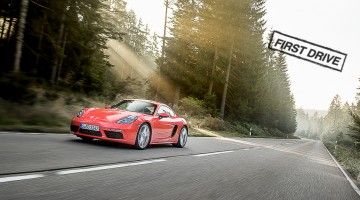Porsche Panamera 4S and Turbo driven on the regional launch in Oman.
[Not a valid template]The Panamera is a model that has split opinion in the Porsche camp since its debut in 2009 in Shanghai. All the elements of classic Porsche design language, from the wings raised above the bonnet line to the slopping roof at the rear, did little to please the Porschephile’s puritanical sense of proportions and Stuttgart’s entry in to the luxury saloon market.
From a driving perspective, however, the Panamera has garnered a reputation as one of the best full-sized luxury saloons available which Porsche attribute to the “race car DNA” which is imbued in to all of its models. Sales figures stand testament to this, especially so in the Middle East where sales have continued to climb in the outgoing model. Time for me to get behind the wheel of the new face-lifted Panamera and experience this first hand on the regional launch in Oman.
Porsche have taken the unprecedented move of releasing ten new Panamera models at once and, here in Muscat, there are gathered together six derivatives for the assembled press to fight over during the day. Aesthetically, the exterior design changes have been minimal even though Porsche themselves are referring to this new face-lifted Panamera as the “second generation”. New bumpers for each of the variants, new headlight units and a redesigned rear with relocated number plate are the obvious, but then, Porsche have always been advocates of the ‘evolution not revolution’ design ethos.
The first Panamera we are nominated to drive is the 4S with a newly developed twin-turbo, three-litre V6 powering all four wheels. Power output is slightly up on the older, naturally aspirated engine of its predecessor. Peak power of 420bhp kicks in at 6,000rpm although there is little opportunity to put it to use as we exit north through Muscat in our mandatory Panamera convoy following a Cayenne lead car. What I can testify to is the incredible ease with which the 4S accelerates. This is put to the test by leaving just enough of a gap between myself and the car in front and persuading the accelerator with a dab of right foot. Initial lag from the twin-turbos is quickly forgotten about as the 4S picks itself up and powers forward with serious purpose without any fuss being made whatsoever by the V6.
At this stage I am in no doubt of the manufacturer’s claimed performance of 0-100 kph in 4.8 seconds in the 4S. And, I am as equally impressed buy the stopping power of the brakes – six-piston fronts/four-piston rears – however, it a slightly frustrating journey towards our destination with little opportunity to put the 4S through its paces. After a few hours, many kilometres and a couple of driver changes later, we arrive at our destination: the stunning Hajar Mountains.
It is also time to change Panamera and, for our jaunt up the squiggly road that leads high in to the mountains above, we will be in the Panamera Turbo. Again, this is an all-wheel drive variant but it is a step up from the 4S in many ways. A 4.8-litre, twin-turbo V8 delivers 520 bhp, a full 100 bhp more than its 4S sibling. It is also the ‘Executive’ – long-wheel base – variant which adds an extra 15cm in length. Hustling this up the hill could be fun.
The interior in the Panamera Turbo is simply stunning with a contrasting black and red leather combination, however, something that I am in two minds about is the Porsche resistance to a central control dial. Although individual switch gear is much more intuitive to use than many toggle systems, the overall aesthetic of the centre console feels cluttered. The buttons of importance are easily found though and activated/deactivated as we set off in our Porsche convoy. Once again, the pace is dictated by the Cayenne lead car as it leads us up the winding road.
Continues on next page.



